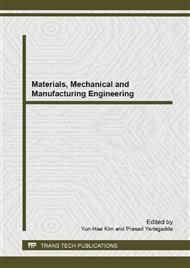p.3
p.7
p.13
p.18
p.22
p.27
p.31
p.35
Influence of Auxiliary Material on the Performance of the Resin Bond Used in Abrasive Tools
Abstract:
The resin bond abrasive tool was prepared by hot pressing in this paper. The effects on the mechanical properties for three auxiliary materials were researched by changing the content of the auxiliary materials in the phenolic resin-based bond in this paper. The samples were tested by the abrasive tool sample's bending strength and Rockwell hardness. It shows that following by increasing the Cr2O3 content, the bending strength and hardness reduced, when the content was 5% and a substantial increase, and when the content was 5%, flexural strength of 9.28%, the hardness increased up 8.93%. When the content of NaHCO3 is 16%, the hardness was reduced by 21.71%, the flexural strength fell by 35.61%. As the SiC powder content increases, the hardness of the abrasive will be a weak decrease, the bending strength decreased more, and when the SiC content of 7%, the hardness decreased by 11.11%, 31.25% of the bending strength decreased, while the grinding efficiency is also reduced.
Info:
Periodical:
Pages:
18-21
Citation:
Online since:
November 2013
Authors:
Keywords:
Price:
Сopyright:
© 2014 Trans Tech Publications Ltd. All Rights Reserved
Share:
Citation:


